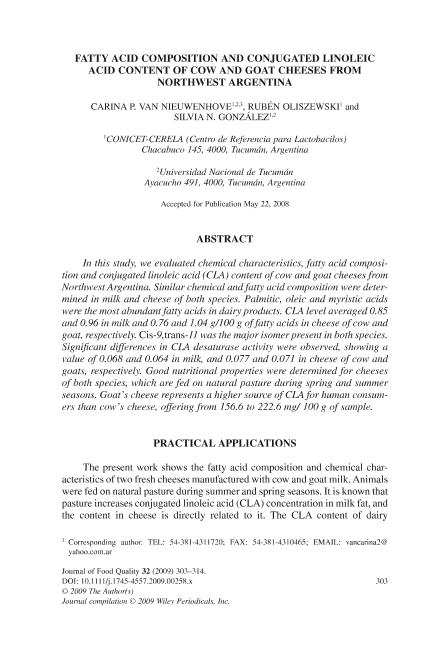Artículo
Fatty acid composition and conjugated linoleic acid content of cow and goat cheeses from northwest Argentina
Fecha de publicación:
06/2009
Editorial:
Wiley Blackwell Publishing, Inc
Revista:
Journal of Food Quality
ISSN:
0146-9428
e-ISSN:
1745-4557
Idioma:
Inglés
Tipo de recurso:
Artículo publicado
Clasificación temática:
Resumen
In this study, we evaluated chemical characteristics, fatty acid composition and conjugated linoleic acid (CLA) content of cow and goat cheeses from Northwest Argentina. Similar chemical and fatty acid composition were determined in milk and cheese of both species. Palmitic, oleic and myristic acids were the most abundant fatty acids in dairy products. CLA level averaged 0.85 and 0.96 in milk and 0.76 and 1.04 g/100 g of fatty acids in cheese of cow and goat, respectively. Cis-9,trans-11 was the major isomer present in both species. Significant differences in CLA desaturase activity were observed, showing a value of 0.068 and 0.064 in milk, and 0.077 and 0.071 in cheese of cow and goats, respectively. Good nutritional properties were determined for cheeses of both species, which are fed on natural pasture during spring and summer seasons. Goat's cheese represents a higher source of CLA for human consumers than cow's cheese, offering from 156.6 to 222.6 mg/ 100 g of sample. PRACTICAL APPLICATIONS The present work shows the fatty acid composition and chemical characteristics of two fresh cheeses manufactured with cow and goat milk. Animals were fed on natural pasture during summer and spring seasons. It is known that pasture increases conjugated linoleic acid (CLA) concentration in milk fat, and the content in cheese is directly related to it. The CLA content of dairy products for the human consumers was analyzed, showing goat cheese with high polyunsaturated fatty acid content, including CLA. Cow and goat fresh cheese offer CLA as many ripening products of different countries, as cheddar or hard cheeses. Lipid composition of food is related to many illnesses, but some compounds are beneficial to human health. The main sources of CLA are milk and cheeses, and in Northwest of Argentina, no data are reported about it, where artisanal cheeses are consumed by the population. Therefore, the atherogenicity index was determined as well.
Archivos asociados
Licencia
Identificadores
Colecciones
Articulos(CERELA)
Articulos de CENTRO DE REFERENCIA PARA LACTOBACILOS (I)
Articulos de CENTRO DE REFERENCIA PARA LACTOBACILOS (I)
Citación
Van Nieuwenhove, Carina Paola; Oliszewski, Ruben; Gonzalez, Silvia Nelina; Fatty acid composition and conjugated linoleic acid content of cow and goat cheeses from northwest Argentina; Wiley Blackwell Publishing, Inc; Journal of Food Quality; 32; 3; 6-2009; 303-314
Compartir
Altmétricas




